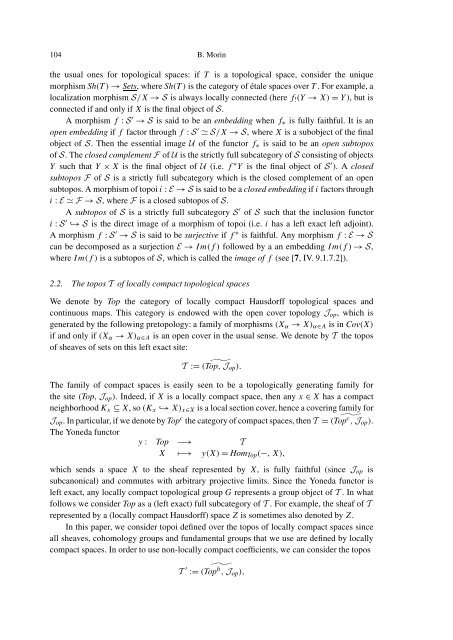THE WEIL-´ETALE FUNDAMENTAL GROUP OF A NUMBER FIELD I
THE WEIL-´ETALE FUNDAMENTAL GROUP OF A NUMBER FIELD I
THE WEIL-´ETALE FUNDAMENTAL GROUP OF A NUMBER FIELD I
You also want an ePaper? Increase the reach of your titles
YUMPU automatically turns print PDFs into web optimized ePapers that Google loves.
104 B. Morin<br />
the usual ones for topological spaces: if T is a topological space, consider the unique<br />
morphism Sh(T ) → Sets,whereSh(T ) is the category of étale spaces over T . For example, a<br />
localization morphism S/X → S is always locally connected (here f ! (Y → X) = Y ), but is<br />
connected if and only if X is the final object of S.<br />
A morphism f : S ′ → S is said to be an embedding when f ∗ is fully faithful. It is an<br />
open embedding if f factor through f : S ′ ≃ S/X → S, whereX is a subobject of the final<br />
object of S. Then the essential image U of the functor f ∗ is said to be an open subtopos<br />
of S.Theclosed complement F of U is the strictly full subcategory of S consisting of objects<br />
Y such that Y × X is the final object of U (i.e. f ∗ Y is the final object of S ′ ). A closed<br />
subtopos F of S is a strictly full subcategory which is the closed complement of an open<br />
subtopos. A morphism of topoi i : E → S is said to be a closed embedding if i factors through<br />
i : E ≃ F → S, whereF is a closed subtopos of S.<br />
A subtopos of S is a strictly full subcategory S ′ of S such that the inclusion functor<br />
i : S ′ ↩→ S is the direct image of a morphism of topoi (i.e. i has a left exact left adjoint).<br />
A morphism f : S ′ → S is said to be surjective if f ∗ is faithful. Any morphism f : E → S<br />
can be decomposed as a surjection E → Im(f) followed by a an embedding Im(f)→ S,<br />
where Im(f) is a subtopos of S, which is called the image of f (see [7, IV. 9.1.7.2]).<br />
2.2. The topos T of locally compact topological spaces<br />
We denote by Top the category of locally compact Hausdorff topological spaces and<br />
continuous maps. This category is endowed with the open cover topology J op ,whichis<br />
generated by the following pretopology: a family of morphisms (X α → X) α∈A is in Cov(X)<br />
if and only if (X α → X) α∈A is an open cover in the usual sense. We denote by T the topos<br />
of sheaves of sets on this left exact site:<br />
T := (Top, ˜J op ).<br />
The family of compact spaces is easily seen to be a topologically generating family for<br />
the site (Top, J op ). Indeed, if X is a locally compact space, then any x ∈ X has a compact<br />
neighborhood K x ⊆ X,so(K x ↩→ X) x∈X is a local section cover, hence a covering family for<br />
J op . In particular, if we denote by Top c the category of compact spaces, then T = (Top ˜c<br />
, J op ).<br />
The Yoneda functor<br />
y : Top −→ T<br />
X ↦−→ y(X) = Hom Top (−,X),<br />
which sends a space X to the sheaf represented by X, is fully faithful (since J op is<br />
subcanonical) and commutes with arbitrary projective limits. Since the Yoneda functor is<br />
left exact, any locally compact topological group G represents a group object of T .Inwhat<br />
follows we consider Top as a (left exact) full subcategory of T . For example, the sheaf of T<br />
represented by a (locally compact Hausdorff) space Z is sometimes also denoted by Z.<br />
In this paper, we consider topoi defined over the topos of locally compact spaces since<br />
all sheaves, cohomology groups and fundamental groups that we use are defined by locally<br />
compact spaces. In order to use non-locally compact coefficients, we can consider the topos<br />
T ′ := (Top ˜h<br />
, J op ),

















